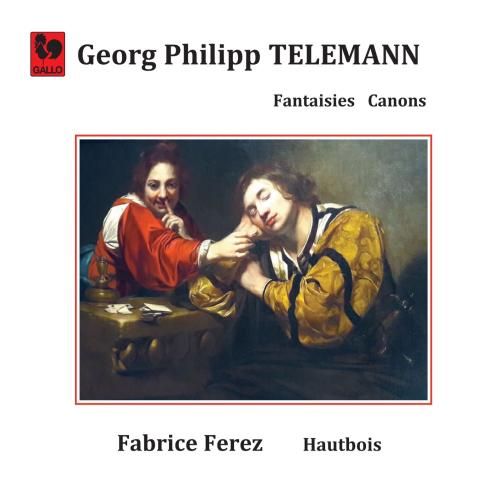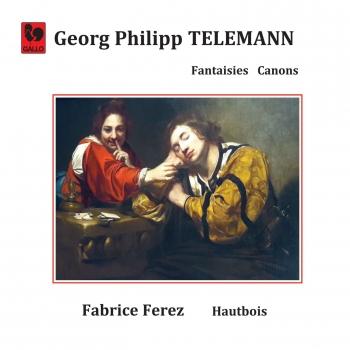
Telemann: Fantasia & Canon for Oboe Solo Fabrice Ferez
Album Info
Album Veröffentlichung:
2020
HRA-Veröffentlichung:
20.11.2020
Label: VDE-GALLO
Genre: Classical
Subgenre: Chamber Music
Interpret: Fabrice Ferez
Komponist: Georg Philipp Telemann (1681-1767), François La Riche (1662-1733)
Das Album enthält Albumcover
- Georg Philipp Telemann (1681 - 1767): Fantasia No. 11 in G Major, TWV 40:12:
- 1 Fantasia No. 11 in G Major, TWV 40:12: I. Allegro 01:22
- 2 Fantasia No. 11 in G Major, TWV 40:12: II. Adagio-Vivace 01:25
- 3 Fantasia No. 11 in G Major, TWV 40:12: III. Allegro 00:48
- Canonic Sonata No. 6 in A Minor, TWV 40:123:
- 4 Canonic Sonata No. 6 in A Minor, TWV 40:123: I. Vivace 01:55
- 5 Canonic Sonata No. 6 in A Minor, TWV 40:123: II. Soave 02:21
- 6 Canonic Sonata No. 6 in A Minor, TWV 40:123: III. Allegro assai 01:59
- Fantasia No. 6 in D Minor, TWV 40:7:
- 7 Fantasia No. 6 in D Minor, TWV 40:7: I. Dolce 01:41
- 8 Fantasia No. 6 in D Minor, TWV 40:7: II. Allegro 01:15
- 9 Fantasia No. 6 in D Minor, TWV 40:7: III. Spirituoso 01:05
- Fantasia No. 1 in A Major, TWV 40:2:
- 10 Fantasia No. 1 in A Major, TWV 40:2: I. Vivace 02:06
- 11 Fantasia No. 1 in A Major, TWV 40:2: II. Allegro 01:18
- Fantasia No. 2 in A Minor, TWV 40:3:
- 12 Fantasia No. 2 in A Minor, TWV 40:3: I. Grave 00:46
- 13 Fantasia No. 2 in A Minor, TWV 40:3: II. Vivace 01:22
- 14 Fantasia No. 2 in A Minor, TWV 40;3: III. Adagio 01:30
- 15 Fantasia No. 2 in A Minor, TWV 40:3: IV. Allegro 00:50
- Canonic Sonata No. 1 in G Major, TWV 40:118:
- 16 Canonic Sonata No. 1 in G Major, TWV 40:118: I. Vivace 01:42
- 17 Canonic Sonata No. 1 in G Major, TWV 40:118: II. Adagio 01:34
- 18 Canonic Sonata No. 1 in G Major, TWV 40:118: III. Allegro 01:46
- Fantasia No. 8 in E Minor, TWV 40:9:
- 19 Fantasia No. 8 in E Minor, TWV 40:9: I. Largo 01:54
- 20 Fantasia No. 8 in E Minor, TWV 40:9: II. Spirituoso 01:08
- 21 Fantasia No. 8 in E Minor, TWV 40:9: III. Allegro 01:00
- Johann Sebastian Bach (1685 - 1750): Partita No. 2 in D Minor, BWV 1004:
- 22 Partita No. 2 in D Minor, BWV 1004: I. Allemande 02:20
- 23 Partita No. 2 in D Minor, BWV 1004: IV. Gigue 02:43
- Georg Philipp Telemann: Fantasia No. 4 in B-Flat Major, TWV 40:5:
- 24 Fantasia No. 4 in B-Flat Major, TWV 40:5: I. Andante 01:27
- 25 Fantasia No. 4 in B-Flat Major, TWV 40:5: II. Allegro 01:35
- 26 Fantasia No. 4 in B-Flat Major, TWV 40:5: III. Presto 00:55
- Wilhelm Friedemann Bach (1710 - 1784): Flute Duet No. 2 in E-Flat Major, F. 55:
- 27 Flute Duet No. 2 in E-Flat Major, F. 55: I. Allegro 03:19
- Georg Philipp Telemann: Canonic Sonata No. 6 in A Minor, TWV 40:123:
- 28 Canonic Sonata No. 6 in A Minor, TWV 40:123: I. Vivace (Accompaniment) 01:55
- 29 Canonic Sonata No. 6 in A Minor, TWV 40:123: II. Soave (Accompaniment) 02:21
- 30 Canonic Sonata No. 6 in A Minor, TWV 40:123: III. Allegro assai (Accompaniment) 02:01
- Canonic Sonata No. 1 in G Major, TWV 40:118:
- 31 Canonic Sonata No. 1 in G Major, TWV 40:118: I. Vivace (Accompaniment) 01:43
- 32 Canonic Sonata No. 1 in G Major, TWV 40:118: II. Adagio (Accompaniment) 01:34
- 33 Canonic Sonata No. 1 in G Major, TWV 40:118: III. Allegro (Accompaniment) 01:46
Info zu Telemann: Fantasia & Canon for Oboe Solo
Telemann, the power of imagination: The cycle of the Twelve fantasias for flute solo, though surrounded by hundreds of oratorios, dozens of passions or operas, holds a singular place in Telemann’s huge work. First of all, it is one of the few rare opuses were engraving and publication was carried out by Telemann himself, in Hamburg, in 1732.
It is also remarkable as the first series of fantasias composed for a wind instrument. This genre, so closely linked to improvisation, was by its very nature intended for keyboard instruments, which were the natural choice of the creators of the time. Diderot’s Encyclopédie actually defines a fantasia as ‘An instrumental work composed as it is performed.’
These Twelve fantasias are a true demonstration of Telemann’s capacity for invention and thus contradict the vision that would make him a composer who was certainly precocious, gifted and prolific but above all routine
and conventional. They vividly sketch out, sometimes in a few notes, musical worlds that take us from the most melancholy to the most joyful exaltation with an astonishing sense of contrast and humour.
One could compare them to the works of the great painters, who sometimes say more in their sketches than in their finished artworks.
Vanitas, Vanitatum: François La Riche (1662-1733), the great French oboist whose playing brought glory to the Dresden orchestra and whom Telemann heard in Berlin in Bononcini’s opera Polyphema, may have dreamed of playing these fantasias. They were originally written for the transverse flute, an instrument brought to the fore by La Riche’s fellow musicians Michel Blavet (1700-1768) and Johann Joachim Quantz (1697-1773). Telemann who gave so much to the oboe would certainly have been seduced by this idea. This instrument was so familiar to him, as the king of French music in his hundreds of orchestral ouvertures.
Over the past few decades and particularly from the moment Heinz Holliger (born in 1939) became well-known, contemporary oboists have adopted the Twelve fantasias for themselves as an interesting repertoire for
solo instrument of the Baroque period and a suitable counterpart for the repertoire of the twentieth century. Performing them also provides the chance for solitary reflection, an opportunity to encounter oneself. In the opening minor key pages of the second, sixth or eight fantasias this encounter reminds him, like the still lives of the 17th century painters of vanity that ‘thus passes the glory of the world.’
Fabrice Ferez, oboe
Fabrice Ferez
Fabrice Ferez is principal oboe in the Victor Hugo Franche Comté Orchestra, oboe teacher at the Greater Besançon Conservatoire and Artistic co-Director of the Tetraktys Ensemble. An insatiable chamber music player, arranger, and occasional conductor and composer, he likes to live and to share music of all kinds.
After studying the oboe in the Conservatoire National Supérieur de Musique in Lyon, Fabrice Ferez joined the Mozart Academies in Prague and Cracow where he attended Maurice Bourgue’s lessons for the oboe and Sandor Vegh’s classes on chamber music.
As a member of the Gustav Mahler Youth Orchestra, he played under Bernard Haitink and Claudio Abbado.
He then performed with different ensembles including the orchestra of the Paris National Opera, the Lyon National Orchestra, the Luxembourg Philharmonic Orchestra and the Flanders Philharmonic Orchestra.
His discography reflects his enthusiasm for chamber music, including as it does works for wind trios by composers from central Europe and a CD dedicated to Schubert and Beethoven. He was also the instigator of a research project on the composer Napoléon Coste, aiming to rediscover the output for oboe and guitar of this romantic virtuoso from Franche Comté who had sunk into oblivion. This effort resulted in a recording in 2009. As Artistic co-Director of the Tétraktys ensemble, he has recorded the Quintet for Piano and Wind by Mozart, the Phantasy quartet by Britten as well as works for quintet and wind trio by Sir Malcolm Arnold. In 2005, in his home département of Drôme, he founded the Festival of the Chapels of Royans Vercors. He continues to run it, always looking out for new types of concert.
He formed a duo with the Swiss pianist Marc Pantillon and in 2014 they recorded a very noteworthy performance dedicated to the Jewish Czech composer Pavel Haas, who was murdered in Theresienstadt in 1944. Claves Records published in 2018 their second recording, devoted to Dutilleux, Messiaen, Hersant and Frank Martin.
An enthusiasm for contemporary music has led him to play regularly the great compositions of today for his instrument, including works by Holliger, Carter, Berio, Lutoslavski, Harvey, Chen and Amy. His repertoire also features the new generation of composers with Au bleu bois by Misato Mochizuki (2000). Two composers have written specially for him. In 2013 Bruno Giner composed Trois silences déchirés for him, and in 2016 Philippe Hersant wrote Shehnaï for him.
Interested in conducting since he was 19, he conducted the Ensemble Orchestral LyonRégion from 1994 to 2000 and the Orchestre Universitaire de Franche-Comté from 1998 to 2005, and was the Musical Director of the Besançon Philharmonic Orchestra from 2001 to 2014.
He also composes whenever he can. He created Nachtstück for woodwind and cello at the festival Musiques en scène in Lyon, and Vamos, a melodrama for eight wind instruments narrator and children’s choir at the Flaine festival. In 2018 the Conservatoire in Dole commissioned him to write Lune for children’s choir, organ and oboe, and Myriam Rignol inaugurated his Leçon des mots for viola da gamba in 2019. His desire to pass on his love of music – and of the oboe – to future generations has resulted in master classes in China, Slovenia, Germany and Switzerland.
Fabrice Ferez has been trusting Buffet Crampon since 1998.
Dieses Album enthält kein Booklet










